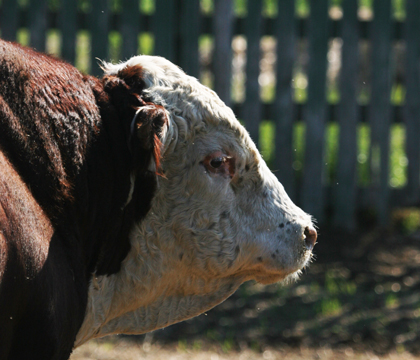
Barth: bull development starts young
Management of nutrition during the development of breeding bulls can be a controversial topic, and nearly all of the discussion focuses on management of bull calves after they're weaned.
By WCVM Today
According to Dr. Albert Barth, nearly all bull development research has concentrated on the post-weaning period. But the theriogenology specialist thinks researchers have overlooked a very important period of development in a bull's lifetime — calfhood.
"There are indications of a strong effect of calfhood nutrition and health on age at puberty and testis size, implying earlier maturity and larger lifetime testis size. I suspect it makes a bigger difference than variations in post-weaning nutrition," said Barth, a professor at the University of Saskatchewan's Western College of Veterinary Medicine.
Barth was one of the speakers at the Applied Reproductive Strategies in Beef Cattle (ARSBC) symposium last December in Sioux Falls, S.D.
"There are indications of a strong effect of calfhood nutrition and health on age at puberty and testis size, implying earlier maturity and larger lifetime testis size."
Barth said there are limited data explaining the effects of calfhood nutrition. Still, evidence suggests smaller scrotal circumference in yearling bulls raised by first-calf heifers (compared to bulls raised by older dams) may be due to lower milk production of their mothers, fetal programming effects or both.
Barth explained how calfhood nutrition affects pituitary gland secretion of gonadotropin hormone. Bull calves experiencing lower gonadotropin secretion are likely destined to mature later and exhibit smaller testes. Studies confirmed that superior calfhood nutrition resulted in higher gonadotropin secretion, resulting in larger testes at a year of age and earlier onset of sperm production.
"It's likely that final testes size is determined before weaning," stated Barth, recommending that management strategies to optimize bull fertility should focus on the time bull calves are still nursing the cow.
"Nutrition throughout calfhood and the postweaning period affects age of puberty, but you can't compensate for restricted energy during calfhood."
Barth urged attention to developing practical health and nutrition programs for young bulls, suggesting an ideal nutrition program should be based on breed and frame size. He recommended a program of moderate cost, allowing for growth at 2.5 pounds (lbs) to 3.0 lbs of gain per day, but avoiding excessive body condition.
High-energy diets fed postweaning may result in larger scrotal circumference at a year of age, but part of the increased size is probably due to scrotal fat.
By Troy Smith for Angus Productions Inc. Visit the ARSBC 2012 conference site to read the original article and to view other conference stories.
"There are indications of a strong effect of calfhood nutrition and health on age at puberty and testis size, implying earlier maturity and larger lifetime testis size. I suspect it makes a bigger difference than variations in post-weaning nutrition," said Barth, a professor at the University of Saskatchewan's Western College of Veterinary Medicine.
Barth was one of the speakers at the Applied Reproductive Strategies in Beef Cattle (ARSBC) symposium last December in Sioux Falls, S.D.
"There are indications of a strong effect of calfhood nutrition and health on age at puberty and testis size, implying earlier maturity and larger lifetime testis size."
Barth said there are limited data explaining the effects of calfhood nutrition. Still, evidence suggests smaller scrotal circumference in yearling bulls raised by first-calf heifers (compared to bulls raised by older dams) may be due to lower milk production of their mothers, fetal programming effects or both.
Barth explained how calfhood nutrition affects pituitary gland secretion of gonadotropin hormone. Bull calves experiencing lower gonadotropin secretion are likely destined to mature later and exhibit smaller testes. Studies confirmed that superior calfhood nutrition resulted in higher gonadotropin secretion, resulting in larger testes at a year of age and earlier onset of sperm production.
"It's likely that final testes size is determined before weaning," stated Barth, recommending that management strategies to optimize bull fertility should focus on the time bull calves are still nursing the cow.
"Nutrition throughout calfhood and the postweaning period affects age of puberty, but you can't compensate for restricted energy during calfhood."
Barth urged attention to developing practical health and nutrition programs for young bulls, suggesting an ideal nutrition program should be based on breed and frame size. He recommended a program of moderate cost, allowing for growth at 2.5 pounds (lbs) to 3.0 lbs of gain per day, but avoiding excessive body condition.
High-energy diets fed postweaning may result in larger scrotal circumference at a year of age, but part of the increased size is probably due to scrotal fat.
By Troy Smith for Angus Productions Inc. Visit the ARSBC 2012 conference site to read the original article and to view other conference stories.
